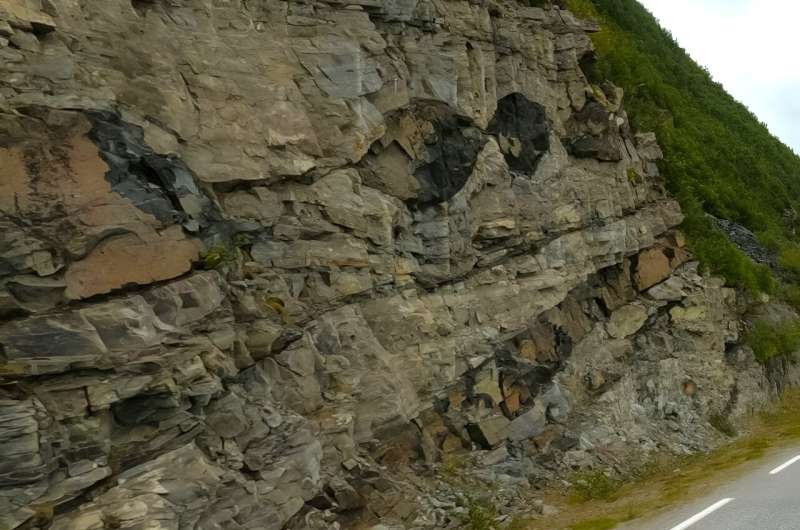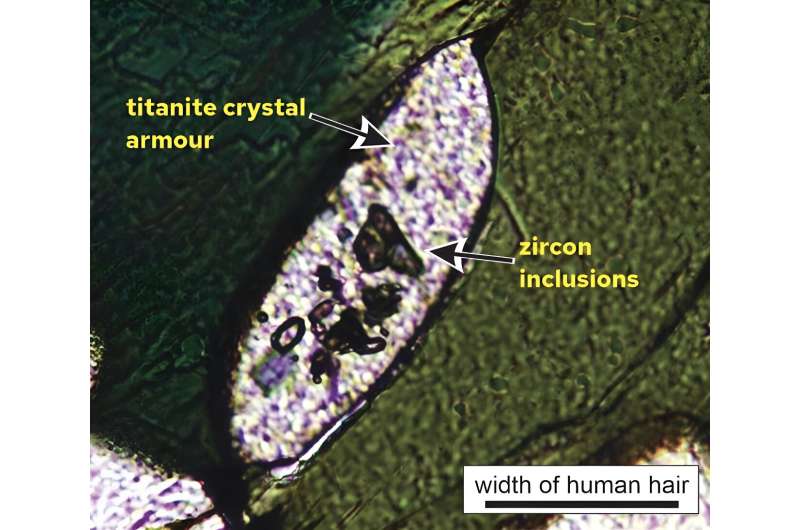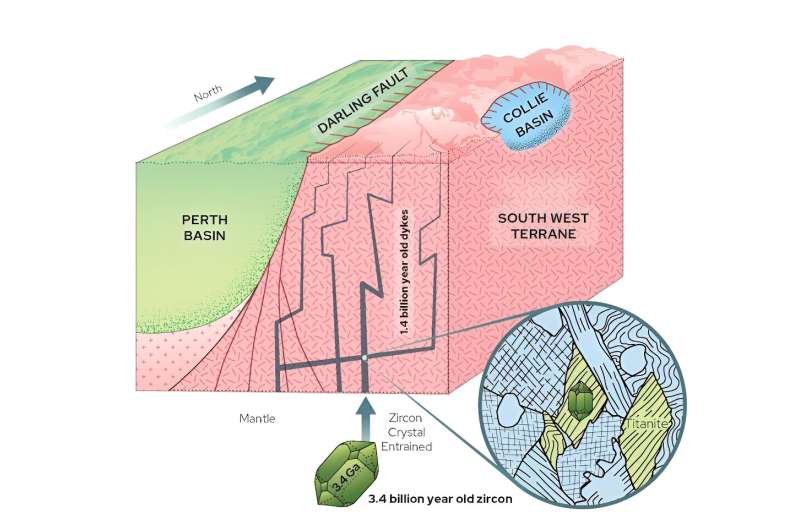
Dyke in Norway cutting into sandstone with older layers. Credit: Cato Andersen/Mapillary, CC BY-SA
Our planet was born about 4.5 billion years ago. To understand this incredibly long history, we must study the rocks and the minerals they are made of.
The oldest rocks in Australia, which are some of the oldest on Earth, are found in Western Australia’s Murchison district, 700 kilometers north of Perth. They have been dated to almost 4 billion years old.
In a new study published in Earth and Environment Communications, we have found evidence of rocks of a similar age near Collie, south of Perth. This suggests that the ancient rocks of Western Australia cover a much larger area than we knew, buried deep in the crust.
Ancient continental crust
Australia’s ancient crust is essential to understanding the early Earth because it tells us how the continental crust formed and developed.
The continental crust forms the foundation of the land masses where humans live, supporting ecosystems and providing essential resources for civilization. Without it there would be no fresh water. It is rich in mineral resources such as gold and iron, making it economically important.
However, exploring the ancient continental crust is not easy. Much of it is deeply embedded, or intensively modified, by its environment. There are only a few exposed areas where researchers can directly observe this ancient crust.
To understand the age and composition of this ancient, hidden crust, scientists often rely on indirect methods, such as studying weathered minerals preserved in overlying basins, or using remote sensors of sound waves, magnetism, or gravity. .
However, there may be another way to look into the deep crust and, with luck, even try it.
Crawling crystals from the depths
Our planet’s crust is often cut by dark fingers of magma, rich in iron and magnesium, which can extend from the upper crust to the Earth’s mantle. These structures, known as dykes, can come from depths of at least 50 kilometers (much deeper than even the deepest well, which extends only 12 kilometers).
These dams can take small amounts of minerals from the depths and transport them up to the surface where we can examine them.
In our latest study, we have uncovered evidence of ancient buried rocks by dating zircon grains from one of these dikes.
Zircon contains small amounts of uranium, which decays to lead over time. By accurately measuring the ratio of lead to uranium in zircon grains, we can tell how long ago the grain crystallized.
This method showed that the zircon crystals from the dam date back to 3.44 billion years ago.
Titanite Armor
The zircons are encapsulated in another mineral, called titanite, which is chemically more stable than the zircon in the dike. Think of a grain of salt, trapped inside a hard-boiled sugar confection, tossed into a hot cup of tea.

Microscope image of titanite grain with zircon crystals trapped inside and shielded. The scale bar in the lower right of the image is 100 microns, about the width of a human hair. Credit: Adapted from Earth and Environment Communications (2024). DOI: 10.1038/s43247-024-01469-6
The stability of the titanite armor protected the ancient zircon crystals through changes in chemical conditions, pressure and temperature as the dam traveled upward. The exposed zircon crystals in the dike were strongly modified during the voyage, obliterating their isotopic record.
However, the armored grains in titanium survived intact to provide a rare glimpse into Earth’s early history.
The dike, itself dated to be about 1.4 billion years old, has provided a unique window into the ancient crust that would otherwise have remained hidden. We also found similar ancient zircon grains further north in sand from the Swan River, which runs through Perth and drains the same region, further proving the age and provenance of these ancient materials.

Cross section of the crust south of Perth showing dikes taking 3.4 billion year old zircon from deep and bringing it to the surface. The inset zoom shows the armoring of this ancient zircon by a titanium mineral shield. Credit: Earth and Environment Communications (2024). DOI: 10.1038/s43247-024-01469-6
The results extend the known area of ancient crust previously known in the Narryer area of the Murchison district.
One reason why it is important to understand the deep crust is because we often find metals at the boundaries between the blocks of this crust. Mapping these blocks can help map out areas to investigate for mining potential.
Relics of deep time
So the next time you pick up a rock and a few mineral grains are hidden in your hand, don’t think about how long those grains might have been.
To understand the time scale, imagine that the history of our planet was one year long. Earth was formed from swirling dust 12 months ago. Every handful of sand you pick up around Perth will contain a grain or two from about ten months ago. Most of Australia’s gold was formed seven months ago, and the land plants arrived only a month ago.
Two weeks ago, the dinosaurs appeared. All of humanity has arrived in the last 30 minutes. And you? Put simply, at this rate, your life would last about half a second.
More information:
Christopher L. Kirkland et al, Cryptic geologic histories accessed through buried geochronometers and matrix in dikes, Earth and Environment Communications (2024). DOI: 10.1038/s43247-024-01469-6
Provided by The Conversation
This article is republished from The Conversation under a Creative Commons license. Read the original article.![]()
citation: Groundbreaking discovery: How researchers found remnants of Earth’s primordial crust near Perth (2024, June 20) Retrieved June 20, 2024 from https://phys.org/news/2024-06-groundbreaking-discovery-remnants-earth-primordial .html.
This document is subject to copyright. Except for any fair agreement for study or private research purposes, no part may be reproduced without written permission. The content is provided for informational purposes only.